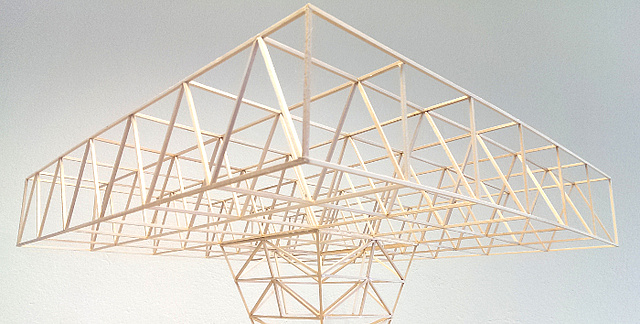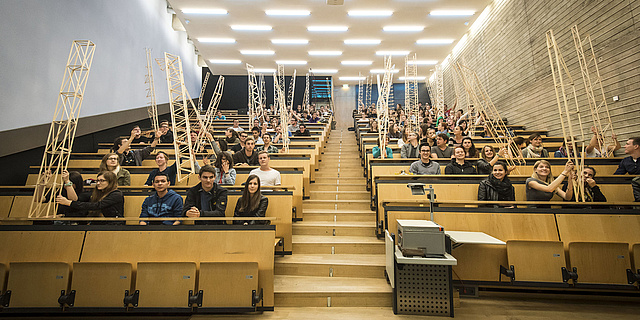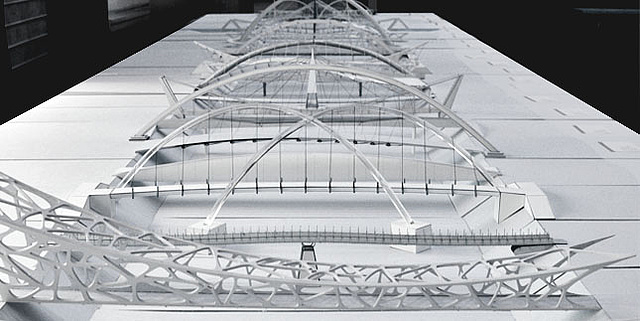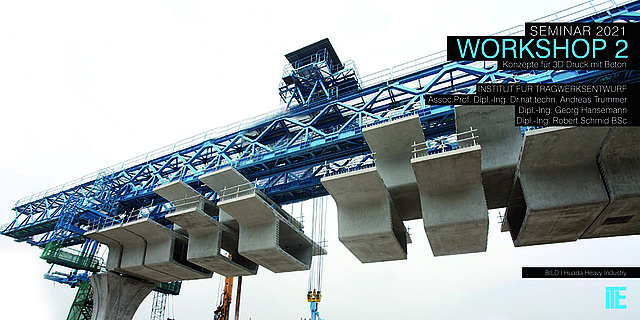Bearing Structure 1 VU

CONTENT
Basics in statics engineering, materials strengths and the task of bearing structures.
- Terms
- Loads
- Force and Moment
- Simple Static Systems and Support Conditions
- Equilibrium State
- Supporting Forces and Internal Forces and Moments
- Stesses
- Selection Properties and Structural Design
- Load Bearing Capercity and Serviceability
- Continuous Beams
OBJECTIVE
Following successful completion of the course, students will have developed an understanding for the tasks of a bearing structure. They will be capable of measuring the forces acting on a building and be able to trace these analytically and using graphic methods in a building.
LINKS
Course in TUGRAZonline
TU Graz TeachCenter
Film clip by ORF about 125 Jahe TU-Graz >> [TWL 1 VU]
Bearing Structure 2 VU

CONTENT
Basics in statics engineering, materials strengths and the task of bearing strctures:
- Buckling
- Bracing of Building Structures
- Truss
- Cable Structures
- Arch
- Frame
OBJECTIVE
Following successful completion of the course students will have developed as understanding for the tasks of basic bearing structures like column, truss, cable, arch and frame.
LINKS
Course in TUGRAZonline
TU Graz TeachCenter
Bearing structure design | Lecture
CONTENT
Basics for merging the various different bearing structure elements into a bearing structure design:
- Construction reinforcement
- Problems of stability, mass and structurally active bearing systems
- Two and three-dimensional systems
- Construction and detailing in accordance with materials
OBJECTIVE
Following successful completion of the course students will be capable of assessing the bearing structure of a building in all its complexity and to understand the interplay between material, construction and form in all their different manifestations and articulations.
Bearing structure design | Practical

CONTENT
Implementation of knowledge gained in previous courses in the design of a bearing structure as an intrinsic part of an architectural design task:
- Determining of bearing parts, static systems
- Flow of forces, concept of reinforcement
- Substantiation and dimensioning
- Constructive design
OBJECTIVE
Following successful completion of the course students will understand the influence of the bearing structure on the architectural design with the help of various elaborated bearing structure types and will be capable to develop a solution for a bearing structure as an intrinsic part of a design task.
LINKS
Course in TUGRAZonline
TU Graz Teachcenter
Workshop 2
CONTENT
Design-related aspects from different architectural fields will be explored and practised in a limited period of time the context of the workshops.
Different methods for dealing with design tasks are taught in the three workshops and tested in practise-related tasks.
OBJECTIVE
Following successful completion of the course students will be able to assess a situation, develop concepts and formulate them ready for presentation in a design within a given timeframe. They will be familiar with how to deal with a task in the course of a single week and will be capable of verbally communicating and presenting their works and designs in models, plans and complementary illustrations.
Capabilities acquired are to be understood as an input for the “design” course and should be applied there.
LINK
Course in TUGRAZonline

